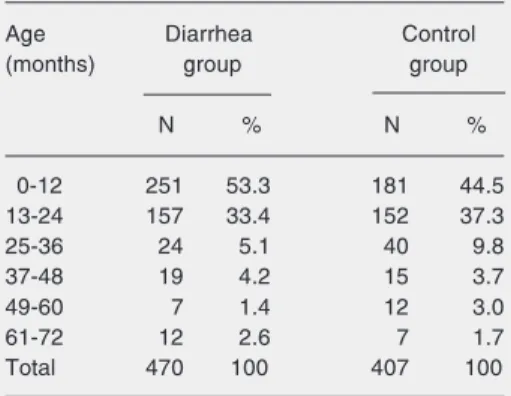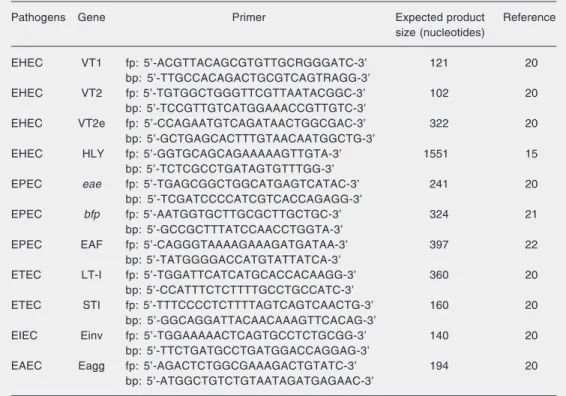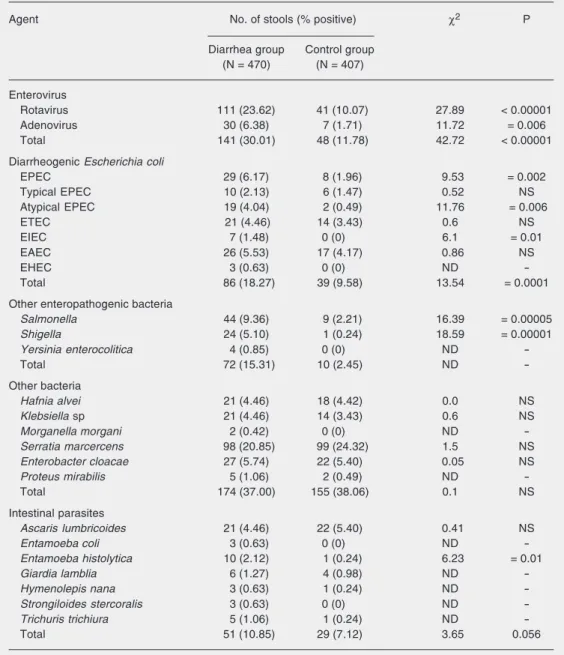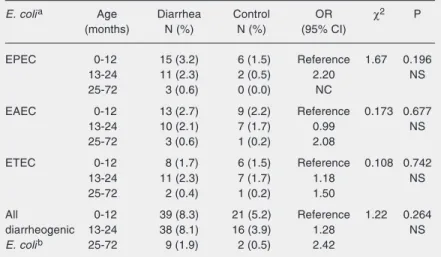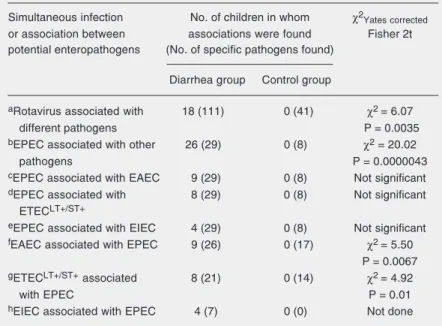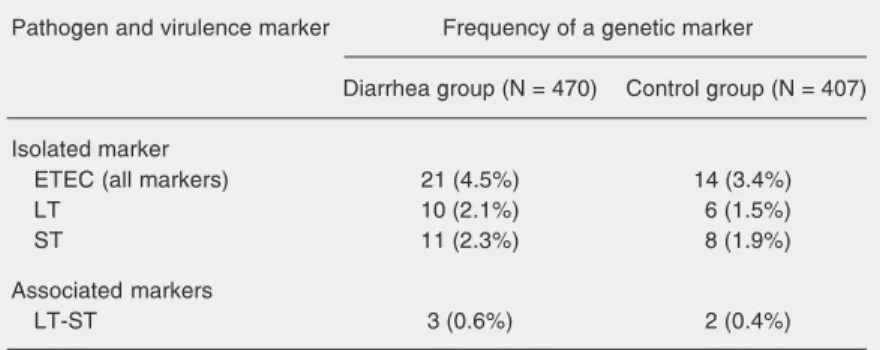Etiology of diarrheal infections in
children of Porto Velho (Rondonia,
Western Amazon region, Brazil)
1Centro de Pesquisa em Medicina Tropical, Porto Velho, RO, Brasil 2Hospital Infantil Cosme e Damião, Porto Velho, RO, Brasil
P.P. Orlandi1,
G.F. Magalhães1,
N.B. Matos1, T. Silva1,
M. Penatti2, P.A. Nogueira1
and L.H. Pereira da Silva1
Abstract
In the present study, 470 children less than 72 months of age and presenting acute diarrhea were examined to identify associated enter-opathogenic agents. Viruses were the pathogens most frequently found in stools of infants with diarrhea, including 111 cases of rotavirus (23.6% of the total diarrhea cases) and 30 cases of adenovi-rus (6.3%). The second group was diarrheogenic Escherichia coli (86 cases, 18.2%), followed by Salmonella sp (44 cases, 9.3%) and Shigella sp(24 cases, 5.1%). Using the PCR technique to differentiate the pathogenic categories of E. coli,it was possible to identify 29 cases (6.1%) of enteropathogenic E. coli (EPEC). Of these, 10 (2.1%) were typical EPEC and 19 (4.0%) atypical EPEC. In addition, there were 26 cases (5.5%) of enteroaggregative E. coli, 21 cases (4.4%) of entero-toxigenic E. coli, 7 cases (1.4%) of enteroinvasive E. coli (EIEC), and 3 cases (0.6%) of enterohemorrhagic E. coli. When comparing the frequencies of diarrheogenic E. coli, EPEC was the only category for which significant differences were found between diarrhea and con-trol groups. A low frequency of EIEC was found, thus EIEC cannot be considered to be a potential etiology agent of diarrhea. Simultaneous infections with two pathogens were found in 39 diarrhea cases but not in controls, suggesting associations among potential enteropathogens in the etiology of diarrhea. The frequent association of diarrheogenic E. coli strains was significantly higher than the probability of their random association, suggesting the presence of facilitating factor(s).
Correspondence
P.P. Orlandi Microbiologia - CEPEM BR 364, km 4.5 Caixa Postal 87
78900-970 Porto Velho, RO Brasil
Fax: +55-69-225-9345 E-mail: pnogueir@cepem.com.br
Research supported by CNPq.
Received September 9, 2004 Accepted December 2, 2005
Key words •Diarrheal disease •Enteropathogens •Escherichia coli •Epidemiology •Western Amazon
Introduction
Persistent and recurrent acute diarrhea is one of the three major causes of morbidity and mortality in the world and accounts for an estimated annual five million deaths among infants under 5 years (1). Diarrhea continues to be endemic in some tropical and subtropical areas and is one of the leading
study performed in the city of Belém, in the Eastern Amazon region, found 5.9 diarrhea episodes per child per year (6).
Several studies have been conducted in the South and Southeast regions of Brazil in order to identify etiological agents associ-ated with diarrhea and to assess the clinical and epidemiological features of the disease (7-14). These studies emphasized the impor-tance of different diarrheogenic Escherichia coli strains and their respective genetic viru-lence determinants.
Few studies on the etiology of diarrhea were performed in urban and peri-urban ar-eas of the Northar-east, Central and Northern regions of Brazil. In these regions, the gen-eralized poor quality or absence of sanita-tion and of a clean water supply for the population introduce additional risk factors for the morbi-mortality of infant diarrhea. In previous studies conducted in Fortaleza (Northeast Brazil) by Guerrant et al. (5) rotavirus appeared to be responsible for 21% of children’s diarrhea cases, followed by
Shigella and Campylobacter. Diarrheogenic
E. coli was found only in 4.6% of cases. However, more recent studies by the same group have emphasized the importance of different pathogenic E. coli strains in per-sistent diarrhea (2). Other recent studies in
the Northeast have confirmed the dominant frequency of rotavirus (21.5% of cases) and
Shigella (16.5%) with a lower frequency of enteropathogenic E. coli (EPEC). An inter-esting observation in this study (2) was the finding of diffusely adherent E. coli, a new category of pathogenic E. coli, detected as an important agent of diarrhea in children over 12 months of age (15). Studies in the Amazon region are even more infrequent. In the city of Belém, Linhares and co-workers (6,16) identified rotavirus as the major etio-logical agent of infant diarrhea and studied the subgroups of viruses found in nosoco-mial cases (6,16).
In the Western Amazon region, the only available information concerns a previous study by our group with preliminary data on the enteropathogens associated with diar-rheal disease in infants from Porto Velho, RO, in the Western Amazon region (17). Among 130 cases of diarrhea, rotavirus ap-peared as the major etiological agent, fol-lowed by Shigella and Salmonella.
The present study was carried out in a children’s Hospital of Porto Velho which attends children from the poor periphery of the city. We studied 470 patients with diar-rhea and 407 age-matched controls less than 5 years of age. An estimation of associated pathogens showed that rotavirus was the major etiological agent associated with diar-rhea cases. However, in contrast to our pre-vious preliminary results, pathogenic E. coli
strains appear to be the second most frequent group associated with diarrhea. Genetic de-terminants of virulence were identified among E. coli pathogenic strains from diar-rhea cases and age-matched controls.
Material and Methods
Study population
Source of specimens. A total of 470 chil-dren under 72 months of age with acute diarrhea lasting at least 48 h and 407
age-Table 1. Age distribution of children with diarrhea and age-matched controls.
Age Diarrhea Control
(months) group group
N % N %
0-12 251 53.3 181 44.5
13-24 157 33.4 152 37.3
25-36 24 5.1 40 9.8
37-48 19 4.2 15 3.7
49-60 7 1.4 12 3.0
61-72 12 2.6 7 1.7
Total 470 100 407 100
matched controls (Table 1) were examined between March 2000 and March 2002 in the Emergency Section of Hospital Infantil Cosme Damião, Porto Velho, RO, Brazil. Relevant clinical information was collected by means of a standard questionnaire, including age, sex, clinical status (fever, vomiting, and de-hydration status), type and duration of diar-rhea, type of water consumed, breast-feed-ing, and a history of antibiotic therapy prior to the visit. Diarrhea was defined as the passage of three or more loose stools within the previous 24 h that conformed to the shape of the container. Dehydration was classified as absent, mild, moderate, or se-vere according to standard criteria (18).
Control children without diarrhea matched for age, sex, and socioeconomic status were recruited from the same Hospital. These chil-dren attended the hospital for non-diarrhea illnesses during the same period of time as the children with diarrhea and had not had diarrhea or other gastrointestinal symptoms or antibiotic therapy during the two preced-ing weeks.
Data concerning breast-feeding practice by each child’s mother as well as the sanita-tion and condisanita-tion of the water supply in their respective residences were collected at admission to the study. Information about the use of treated or untreated water in the preparation of food was also obtained.
Search for pathogens in the stools
Fecal samples were collected after natu-ral evacuation or through stimulation with a glycerin suppository. Stools were divided into two fractions: one was used for parasi-tologic examination for helminth eggs and protozoan cysts by the method of Hoffman et al. (19). The same fraction was tested for the presence of rotavirus using the Slidex kit of Richmond (Rich Diagnostics, New Bruns-wick, NJ, USA) and enzyme-linked immu-nosorbent assays using kits from Bioman-guinhos (EIARA-BiomanBioman-guinhos, Rio de
Ja-neiro, RJ, Brazil). The second aliquot was processed by routine microbiological and biochemical tests from Biomerieux (Paris, France; API 20E) to identify E. coli, Salmo-nella spp, Shigella spp and Yersinia entero-colitica. Three to 5 lactose-fermenting colo-nies and up to 3 lactose-negative colocolo-nies from each child were selected from Mac-Conkey (Difco, Le Pont de Claix, France) plates to be tested by standard and PCR procedures. Shigella and Salmonella strains were selected from SS agar, XLD agar, and VB agar (Difco). Y. enterocolitica strains were identified by means of a polyvalent serum (Y. enterocolitica polyvalent) and four monovalent sera: 03, 05, 08, and 09 (Probac, São Paulo, SP, Brazil).
DNA of Escherichia coli strains used as
control in PCR
The positive control E. coli strains used for PCR included: EDL933 (for Shiga-like toxins I and II, H10407 (for heat-labile tox-ins [LT] and stable-labile [ST] enterotox-ins); EDL1284 (for invasion); E2348/69 (for EPEC adherence factor, and attachment-ef-facement factor); 17-2 (for aggregative ad-herence), and C1845 (for diffuse adherence). The non-pathogenic E. coli strain HB101 was used as negative control and to monitor PCR contamination.
DNA extraction
Eppen-dorf tubes on a BioRad Thermal cycler (Lon-don, UK) in a reaction volume of 50 µL.
PCR procedures
PCR amplifications were performed as follows: 5.0 µL of bacterial extract was added to the reaction mixture with a final volume of 50 µL containing 0.1 mM each dATP, dCTP, dGTP and dTTP, PCR buffer (10 mM Tris-HCL, pH 8.3, 50 mM KCl, 2 mM MgCl2), 10 pMol of each PCR primer, and 1
U Taq DNA polymerase. Amplification was performed in a BioRad thermal cycler, as follows: denaturation for 30 s at 92ºC, an-nealing for 1 min at 57ºC, and extension for 1 min at 72ºC (30 cycles). The amplification process was followed by a 5-min extension at 72ºC, and the tubes were rapidly cooled to
4ºC. The amplified DNA products were re-solved by agarose gel electrophoresis (2%) and visualized by UV trans-illumination af-ter ethidium bromide staining.
Analysis of virulence factors of Escherichia coli by PCR
To determine the presence of diarrheo-genic E. coli among the selected subcul-tures, PCR tests were carried out for genes encoding thermolabile toxins (I and LT-II) and thermostable toxins (STI) produced by enterotoxigenic E. coli (ETEC) and verotoxin types 1, 2, and 2e produced by enterohemorrhagic E. coli (EHEC). Oligo-nucleotide primers used to detect specific virulence determinants are presented in Table 2. Other factors such as enteroaggregative
Table 2. Sequences of PCR primers and expected product sizes.
Pathogens Gene Primer Expected product Reference
size (nucleotides)
EHEC VT1 fp: 5'-ACGTTACAGCGTGTTGCRGGGATC-3' 121 20
bp: 5'-TTGCCACAGACTGCGTCAGTRAGG-3'
EHEC VT2 fp: 5'-TGTGGCTGGGTTCGTTAATACGGC-3' 102 20
bp: 5'-TCCGTTGTCATGGAAACCGTTGTC-3'
EHEC VT2e fp: 5'-CCAGAATGTCAGATAACTGGCGAC-3' 322 20
bp: 5'-GCTGAGCACTTTGTAACAATGGCTG-3'
EHEC HLY fp: 5'-GGTGCAGCAGAAAAAGTTGTA-3' 1551 15
bp: 5'-TCTCGCCTGATAGTGTTTGG-3'
EPEC eae fp: 5'-TGAGCGGCTGGCATGAGTCATAC-3' 241 20
bp: 5'-TCGATCCCCATCGTCACCAGAGG-3'
EPEC bfp fp: 5'-AATGGTGCTTGCGCTTGCTGC-3' 324 21
bp: 5'-GCCGCTTTATCCAACCTGGTA-3'
EPEC EAF fp: 5'-CAGGGTAAAAGAAAGATGATAA-3' 397 22
bp: 5'-TATGGGGACCATGTATTATCA-3'
ETEC LT-I fp: 5'-TGGATTCATCATGCACCACAAGG-3' 360 20
bp: 5'-CCATTTCTCTTTTGCCTGCCATC-3'
ETEC STI fp: 5'-TTTCCCCTCTTTTAGTCAGTCAACTG-3' 160 20
bp: 5'-GGCAGGATTACAACAAAGTTCACAG-3'
EIEC Einv fp: 5'-TGGAAAAACTCAGTGCCTCTGCGG-3' 140 20
bp: 5'-TTCTGATGCCTGATGGACCAGGAG-3'
EAEC Eagg fp: 5'-AGACTCTGGCGAAAGACTGTATC-3' 194 20
bp: 5'-ATGGCTGTCTGTAATAGATGAGAAC-3'
mechanisms, and enteroinvasive mechan-isms were also analyzed. The following fac-tors were analyzed in order to characterize the EPEC strains: a fragment of the eae
gene, the bfpA gene, the EPEC adherence factor plasmid, and the locus for enterocyte effacement insertion site.
Statistical analysis
The prevalence of diarrheogenic E. coli
in patients and controls was compared by the two-tailed χ2 test and Fisher’s exact test with
Yates’ correction. When analyzing the asso-ciation of two or three pathogens in the same diarrheal patient, the same test was used to evaluate the probability of association by random chance as a function of their respec-tive individual frequency in the population.
Results
Pathogens associated with diarrhea
Table 3 describes the number of patho-genic and non-pathopatho-genic agents detected in the stools of both groups. Enterovirus was the major cause of disease in the diarrhea group (30%), while rotavirus and adenovi-ruswere found in 111 (23.6%) and 30 (6.3%) stools, respectively, among the 470 patients. However, enterovirus was also found in 11.7% of the stools from the control group (Table 3).
Diarrheogenic E. coli was found in 86 (18.2%) children with diarrhea, represent-ing the second group in order of frequency. For this reason, the characterization of diar-rheogenic E. coli was performed by PCR. EPEC was the strain most frequently associ-ated with diarrhea (6.1% of cases, with 2.1% being typical EPEC and 4.0% atypical EPEC), followed by enteroaggregative E. coli (EAEC) (5.5%) and ETEC (4.4%). En-teroinvasive E. coli (EIEC) and EHEC strains were found at lower frequencies, with only 7 cases (1.4%) and 3 cases (0.6%),
respective-ly. However, it is important to emphasize that these two minor variants were found only in patients with diarrhea and not in the controls.
Among other enteropathogenic bacteria,
Salmonella sp with 44 cases (9.3%) and
Shigella species with 24 cases (5.1%) were in third and fourth positions, respectively. All of these pathogenic bacteria were iso-lated from the control group, but at lower frequencies (Table 3). Y. enterocolitica was isolated in 4 cases (0.8%).
Pathogens found in matched controls
The major pathogens were found in stools of age-matched children from the control group (Table 3), but their frequency was significantly lower compared to the infected group. Comparing the number of stools from which enterovirus was isolated, 141 from the diarrhea group (N = 470) and 48 from control group (N = 407), a χ2Mantel Haenszel of
42.72 was observed (P < 0.0000001). One hundred and one rotaviruses found in the diarrhea group and 41 in the control give a
χ2Mantel Haenszel of 27.89 (P = 0.0000001). For
adenovirus the χ2Mantel Haenszel was 11.72, with
P = 0.0006 (30 in diarrhea group and 7 in the control group).
The frequency of all diarrheogenic E. coli
strains was significantly higher in the diar-rhea group than in the control group, with 86 and 39 isolates, respectively (χ2Mantel Haenszel =
13.54; P = 0.0001). The frequencies of 29 EPEC in the diarrhea group and 8 in the control group were significantly different (χ2Mantel Haenszel = 9.53; P = 0.002). However,
the difference was no longer significant when we analyzed typical EPEC individually. Re-garding EIEC, the χ2Mantel Haenszel was 6.01 (P
= 0.01). The frequency of EHEC was too low for the use of statistical tests and the frequencies of EAEC and ETEC were not significantly different between the diarrhea and control groups.
ob-Table 3. Pathogenic and non-pathogenic agents isolated from stools of children with diarrhea and age-matched controls.
Agent No. of stools (% positive) χ2 P
Diarrhea group Control group (N = 470) (N = 407)
Enterovirus
Rotavirus 111 (23.62) 41 (10.07) 27.89 < 0.00001
Adenovirus 30 (6.38) 7 (1.71) 11.72 = 0.006
Total 141 (30.01) 48 (11.78) 42.72 < 0.00001
Diarrheogenic Escherichia coli
EPEC 29 (6.17) 8 (1.96) 9.53 = 0.002
Typical EPEC 10 (2.13) 6 (1.47) 0.52 NS
Atypical EPEC 19 (4.04) 2 (0.49) 11.76 = 0.006
ETEC 21 (4.46) 14 (3.43) 0.6 NS
EIEC 7 (1.48) 0 (0) 6.1 = 0.01
EAEC 26 (5.53) 17 (4.17) 0.86 NS
EHEC 3 (0.63) 0 (0) ND
-Total 86 (18.27) 39 (9.58) 13.54 = 0.0001
Other enteropathogenic bacteria
Salmonella 44 (9.36) 9 (2.21) 16.39 = 0.00005 Shigella 24 (5.10) 1 (0.24) 18.59 = 0.00001 Yersinia enterocolitica 4 (0.85) 0 (0) ND
-Total 72 (15.31) 10 (2.45) ND
-Other bacteria
Hafnia alvei 21 (4.46) 18 (4.42) 0.0 NS Klebsiella sp 21 (4.46) 14 (3.43) 0.6 NS Morganella morgani 2 (0.42) 0 (0) ND -Serratia marcercens 98 (20.85) 99 (24.32) 1.5 NS Enterobacter cloacae 27 (5.74) 22 (5.40) 0.05 NS Proteus mirabilis 5 (1.06) 2 (0.49) ND
-Total 174 (37.00) 155 (38.06) 0.1 NS
Intestinal parasites
Ascaris lumbricoides 21 (4.46) 22 (5.40) 0.41 NS
Entamoeba coli 3 (0.63) 0 (0) ND
-Entamoeba histolytica 10 (2.12) 1 (0.24) 6.23 = 0.01 Giardia lamblia 6 (1.27) 4 (0.98) ND -Hymenolepis nana 3 (0.63) 1 (0.24) ND -Strongiloides stercoralis 3 (0.63) 0 (0) ND -Trichuris trichiura 5 (1.06) 1 (0.24) ND
-Total 51 (10.85) 29 (7.12) 3.65 0.056
Dataare reported as the number of stools from children in the diarrhea and control groups from which each pathogen was isolated and the percentage of each pathogen isolated from the stools of the children in each group. A total of 281 pathogenic or non-pathogenic agents were isolated from the control group. No enteropathogen was isolated from the stools of 126 control children. For abbreviations of Escherichia coli strains, see legend to Table 2. The two-tailed χ2Mantel Haenszel test and Fisher’s exact test with Yates corrections were used for statistical analysis. ND = not determined; NS = not significant.
served when comparing the frequencies of
Salmonella sp (χ2Mantel Haenszel = 16.39; P =
0.00005) and Shigella sp χ2Mantel Haenszel =
18.59; P = 0.00001) between groups. Other bacteria, enteropathogenic
Cryptospori-dium. In addition, the Hoffman technique adopted for parasitological stool examina-tion is valid only for the detecexamina-tion of cysts and not of the vegetative protozoan forms that are present in acute diarrhea stools. Nevertheless, other bacteria and intestinal parasites were found in the diarrhea group, sometimes simultaneously, increasing the number of isolates in the diarrhea group. These minor enteropathogens were found in stools of the control group, with frequencies similar to the diarrhea group. The exception was Entamoeba histolytica, whose frequen-cies in both groups were statiscally different (χ2Mantel Haenszel = 6.23; P = 0.01).
In summary, the frequencies of all major enteropathogens such as enterovirus, diar-rheogenic E. coli and other enteropathogen-ic bacteria were higher in the diarrhea group (Table 3).
Analysis by the χ2 test for linear trend in
proportions (Epi-6 package) was performed to determine whether the presence of some diarrheogenic E. coli strains was dependent on age in both groups. Although only 9 diarrheogenic E. coli strains were isolated from children older than 24 months (Table 4), no significant difference was found be-tween the diarrhea and control groups by linear trend in proportions, nor were any differences detected for EPEC, EAEC or ETEC (Table 4).
It was possible to characterize the etiol-ogy of diarrhea in 299 stool samples from the 470 children in the diarrhea group by the presence of potential pathogenic agents (141 cases of enterovirus, 86 of diarrheogenic E. coli, and 72 of other enteropathogenic bacte-ria, Table 3), whereas the etiology of diar-rhea could not be identified in the other 171 children.
It is important to note that simultaneous infection with more than one potential enteropathogen was observed in 39 stool samples from the diarrhea group, whereas no case of simultaneous infection was ob-served in the control group. Rotavirus and
enteropathogenic bacteria were isolated in 18 cases. Among the diarrheogenic E. coli, EPEC was the major category with simulta-neous infection, with 26 cases of 29 detected in the diarrhea group.
Simultaneous infection found in stools with potential enteropathogens could be im-portant to the etiology of diarrhea. Table 5 shows that i) among 111 rotavirus-positive stools from the diarrhea group, a combina-tion of different enteropathogens was de-tected in 18 samples, Shigella spp in 3 cases,
Salmonella in 7 cases, and diarrheogenic E. coli in 8 cases (EIEC in 2 cases, EAEC in 1 case and EPEC in 5 cases). Although rota-virus was isolated from 41 stools of the control group, no other enteropathogen was detected in simultaneous infection (χ2Yates
6.07; Fisher-2t = 0.0035). ii) The more sur-prising finding of simultaneous infection was observed with different diarrheogenic E. coli. Twenty-six potential enteropathogens were detected in 29 EPEC-positive stools from
Table 4. Analysis of some diarrheogenic Escherichia coli strains isolated from children with diarrhea and from age-matched controls in relation to months of age.
E. colia Age Diarrhea Control OR χ2 P
(months) N (%) N (%) (95% CI)
EPEC 0-12 15 (3.2) 6 (1.5) Reference 1.67 0.196
13-24 11 (2.3) 2 (0.5) 2.20 NS
25-72 3 (0.6) 0 (0.0) NC
EAEC 0-12 13 (2.7) 9 (2.2) Reference 0.173 0.677
13-24 10 (2.1) 7 (1.7) 0.99 NS
25-72 3 (0.6) 1 (0.2) 2.08
ETEC 0-12 8 (1.7) 6 (1.5) Reference 0.108 0.742
13-24 11 (2.3) 7 (1.7) 1.18 NS
25-72 2 (0.4) 1 (0.2) 1.50
All 0-12 39 (8.3) 21 (5.2) Reference 1.22 0.264
diarrheogenic 13-24 38 (8.1) 16 (3.9) 1.28 NS
E. colib 25-72 9 (1.9) 2 (0.5) 2.42
Data are reported as the number (%) of children in both groups from whom these diarrheogenic E. coli were isolated. aOnly these categories of diarrheogenic E. coli
could be investigated because of the low frequencies of other categories. bAll
were not statistically significant (Table 5). However, the frequencies of EPEC in relation to EAEC-positive stools or ETECLT+/ST+
-posi-tive stools from the diarrhea and control groups were significantly different (χ2Yates corrected =
5.50 and P = 0.0067; χ2Yates corrected = 4.92 and
Fisher 2t = 0.01, respectively). Thus, we identified simultaneous infection only in the diarrhea group, suggesting associations of these potential enteropathogens in the etiol-ogy of diarrhea.
Differences in the frequency of ETEC strains and the presence of genetic markers corresponding to the described ETEC toxins were investigated in strains isolated from patients and controls (Table 6). No signifi-cant differences in the frequency of the indi-vidual markers LT and ST and toxins were observed between groups.
Breast-feeding, consumption of treated water and diarrhea
Breast-feeding, appropriate sanitation and a clean water supply were shown to be im-portant factors for the protection of children against diarrhea. Analysis of the data from the questionnaire revealed that more than 85% of the mothers of both groups regularly breast-fed their children until 2 years of age or more. Treated water (filtered or boiled) was also commonly used by the mothers of children with diarrhea (78.8%) and of the controls (69.5%). However, there was no evidence that these measures significantly reduced diarrheal infections. We accepted the replies of the mothers as truthful and did not check these conditions by visiting their homes.
Discussion
The results of the present study confirm and extend data of our previous study (17) concerning the major importance of enterovi-rus, particularly rotavienterovi-rus, as the principal etiologic agent in 23.6% cases of infant diar-the diarrhea group (rotavirus in 5 cases,
ETECLT+/ST+ in 8 cases, EIEC in 4 cases, and
EAEC in 9 cases). Among 8 EPEC-positive stools from the control group, no other enteropathogen was detected. This differ-ence was statistically significant (χ2Yates
20.02; Fisher-2t = 0.0000043). When we analyzed the frequencies of EAEC, ETEC or EIEC individually in relation to the EPEC-positive stools of both groups, the differences
Table 5. Description and chi-square analysis of associated pathogens in the diarrhea group.
Simultaneous infection No. of children in whom χ2Yates corrected
or association between associations were found Fisher 2t potential enteropathogens (No. of specific pathogens found)
Diarrhea group Control group
aRotavirus associated with 18 (111) 0 (41) χ2 = 6.07
different pathogens P = 0.0035
bEPEC associated with other 26 (29) 0 (8) χ2 = 20.02
pathogens P = 0.0000043
cEPEC associated with EAEC 9 (29) 0 (8) Not significant dEPEC associated with 8 (29) 0 (8) Not significant
ETECLT+/ST+
eEPEC associated with EIEC 4 (29) 0 (8) Not significant fEAEC associated with EPEC 9 (26) 0 (17) χ2 = 5.50
P = 0.0067
gETECLT+/ST+ associated 8 (21) 0 (14) χ2 = 4.92
with EPEC P = 0.01
hEIEC associated with EPEC 4 (7) 0 (0) Not done
aIn 18 of 111 rotavirus-positive samples from the diarrhea group, different pathogens
were found in association with rotavirus: Shigella spp in 3 cases, Salmonella spp in 7 cases, diarrheogenic Escherichia coli in 8 cases (EIEC: 2 cases; EAEC: 1 case, EPEC: 5 cases). In 41 stool samples from the control group in which rotavirus was identified, no association was found. bIn 26 of 29 EPEC-positive samples from the
diarrhea group, associations with rotavirus or different diarrheogenic E. coli strains were found: rotavirus in 5 cases, ETEC (LT+/ST+) in 8 cases, EIEC in 4 cases, and EAEC in 9 cases. In 8 stool samples from the control group from which EPEC was isolated, no association was found. cIn 29 EPEC-positive samples from the diarrhea
group, we analyzed specific association between EPEC and EAEC. dIn 29
EPEC-positive samples from the diarrhea group, we analyzed specific association between EPEC and ETEC. eIn 29 EPEC-positive samples from the diarrhea group, we analyzed
specific association between EPEC and EIEC. fIn 9 of 26 EAEC-positive samples from
the diarrhea group, association with EPEC was detected. In 17 stool samples from the control group, from which EAEC was isolated, no association was found. gIn 8 of
21 ETECLT+/ST+-positive samples from the diarrhea group, EPEC was found in
asso-ciation with ETECLT+/ST+. In 14 stool samples from the control group, from which
ETECLT+/ST+ was isolated, no association was found. hIn 4 of 7 EIEC-positive samples
rhea. This is also in agreement with other studies conducted in São Paulo (13) and in the Eastern Amazon region (6,23).
Studies of the interaction and importance of different pathogenic E. coli strains associ-ated with acute diarrhea in Brazil have not fully clarified this issue. Pioneering studies by Gomes and co-workers in São Paulo (9) indicated EPEC as the major etiologic agent of infant diarrhea, with indices even higher than those of rotavirus. In a longitudinal study conducted in Fortaleza (2), only ETEC strains were significantly associated with diarrhea. Rodrigues and co-workers (11) suggested that EAEC is the major diarrheo-genic E. coli strain, either alone or in asso-ciation with rotavirus. In our preliminary study, we had identified EPEC, ETEC and EIEC strains in association with diarrhea but the number of cases was too small for statis-tical analysis. In the present study, among diarrheogenic E. coli strains, EPEC appears to be the major strain associated with diar-rhea. There was a statistically significant association of EIEC or EHEC strains with EPEC in cases of diarrhea, in spite of the low number of registered cases. In contrast, no clear association of EAEC and ETEC with diarrhea was demonstrable. The frequencies of these strains in the stools of diarrheal cases and controls were not significantly different.
A recent study by Sperandio et al. (24) indicated that classical DNA markers alone are insufficient to define virulence. The study showed the existence of other still unsus-pected genetic determinants, either directly linked to a pathogenic effect, such as adhes-ins and toxadhes-ins, or acting indirectly through expression of virulent genes and/or on the secretion of their products. Elias Jr. and co-workers (7) have shown that the expression of aggregative adherence fimbria II depends on genetic factors present in two regions of a large plasmid. Elias and co-workers (25) deleted the bfp operon responsible for the synthesis of bundle-forming pili. However,
the deleted strain was still able to adhere to HEp-2 cells, indicating an alternative mech-anism of adhesion. In 1998, Sperandio et al. (24) had shown that the locus for enterocyte effacement pathogenic island in the chromo-some of E. coli presented a polymorphic structure for the 3 loci involved in the secre-tion of the eae gene product. More recently, in EPEC strains with a conserved locus for enterocyte effacement, they observed no dif-ferences between diarrhea cases and con-trols in relation to the presence of the eae
gene (25). They concluded that the presence of eae is not sufficient to define virulence and assigned more significance to the results of fluorescent actin staining in the E. coli -cell interaction model, which reflects the interaction of intimin (the eae product) with the cell actin. The mechanisms of these in-teractions are presently not understood.
We found some simultaneous infection with rotavirus and different enteropathogens such as Shigella, Salmonella, and diarrheo-genic E. coli, but the more striking fact was that diarrhea caused by EPEC seemed to occur only in association with other entero-pathogens. In stools from the diarrhea group in which EPEC was detected, the frequency of simultaneous infection with rotavirus or other diarrheogenic E. coli was prominent, while in the eight isolates from the control group EPEC was the only pathogen present
Table 6. Genetic markers found in enterotoxigenic Escherichia coli (ETEC) isolated from children with diarrhea and age-matched controls.
Pathogen and virulence marker Frequency of a genetic marker
Diarrhea group (N = 470) Control group (N = 407)
Isolated marker
ETEC (all markers) 21 (4.5%) 14 (3.4%)
LT 10 (2.1%) 6 (1.5%)
ST 11 (2.3%) 8 (1.9%)
Associated markers
LT-ST 3 (0.6%) 2 (0.4%)
(Table 5). When we analyzed individually simultaneous infection of EPEC with the various categories of diarrheogenic E. coli, the differences were not significant, but when we analyzed EAEC or ETEC individually with EPEC these differences were signifi-cant, suggesting that there is an effect of the cooperation between these categories of E. coli and EPEC. The mechanisms of this cooperation are obscure; however, Elias Jr. and co-workers (7) recently reported an atypi-cal adhesion profile in cell adhesion assays between EPEC isolates in the presence of O125:H6 EAEC from a diarrhea case. It has been speculated that simultaneous growth of associated EPEC and EAEC may be facili-tated by horizontal transfer of genetic mark-ers.
The most important finding of the pres-ent study in relation to the observations of Elias Jr. and co-workers (7) was the clear association of double (mixed) infections with diarrhea. No association of putative patho-gens was found in stools from children of the control group, while 39 of the 470 children in the diarrhea group presented the associa-tion of two different pathogens as the etio-logic agents of diarrhea (Table 5).
Diarrhea reflects bacterial proliferation in the gut, with increasing cell numbers that may eventually facilitate genetic exchange. The cytolethal distending toxin described in O86:H34 E. coli was also detected in other enteric bacteria such as Shigella and Campy-lobacter (26).
Adenoviruses, other bacterial pathogens like Y. enterocolitica, and protozoa (E. his-tolytica and Giardia lamblia) were also found in diarrhea cases at lower frequencies. How-ever, the participation of enteropathogenic protozoa could not be properly evaluated since no specific examination for Crypto-sporidium was performed and the parasito-logical stool examination used did not detect vegetative forms of Entamoeba and Giardia.
In the present study, the data concerning breast-feeding practice by each child’s mother, as well as sanitation and water sup-ply conditions in their respective residences, were collected at admission to the study. Information was also obtained about the use of treated or untreated water in the prepara-tion of complementary food. There was no evidence that these measures represented a significant risk of diarrhea infection nor did they prevent infection.
The age distribution of diarrhea cases drops sharply after 24 months of age, sug-gesting the development of resistance against all etiologic agents. Immunity to enteropatho-gens should be investigated. One might speculate that mothers are less stressed and attentive to illness when their children start to develop greater autonomy after 2 years age. While our child sample corresponds to symptomatic patients looking for medical care at the Hospital, the age distribution in our study was the same as observed in an active search for cases in longitudinal stud-ies (2).
References
1. Georges MC, Wachsmuth IK, Meunier DM et al. (1984). Parasitic, bacterial and viral enteric pathogens associated with diarrhea in the Central African Republic. Journal of Clinical Microbiology, 19: 571-575.
2. Lima AA, Moore SR, Barboza Jr MS et al. (2000). Persistent diar-rhea signals a critical period of increased diardiar-rhea burdens and nutritional shortfalls: a prospective cohort study among children in Northeasten Brazil. Journal of Infectious Diseases, 181: 43-51. 3. Murray JL & Lopez AD (1997). The Global Burden of Disease: A
Comprehensive Assessment of Mortality and Disability from Dis-eases Injuries, and Risk Factors in 1900 and Projected to 2020. Harvard University Press, Cambridge, MA, USA.
4. Bern C, Martines J, de Zoysa I et al. (1992). The magnitude of the global problem of diarrhoeal disease: a ten years update. Bulletin of the World Health Organization, 70: 705-714.
5. Guerrant RL, Kirchhoff LV, Shields DS et al. (1983). Prospective study of diarrheal illnesses in Northeastern Brazil: patterns of dis-ease, nutritional impact, etiologies, and risk factors. Journal of Infec-tious Diseases, 148: 986-997.
6. Linhares AC (1997). Rotavirus infection in Brazil: epidemiology, immunity, and potential vaccination. Brazilian Journal of Infectious Diseases, 1: 284-293.
7. Elias Jr WP, Czeczulin JR, Henderson IR et al. (1999). Organization of biogenesis genes for aggregative adherence fimbria II defines a virulence gene cluster in enteroaggregative Escherichia coli. Jour-nal of Bacteriology, 181: 1779-1785.
8. Gomes TAT, Vieira MA, Abe CM et al. (1998). Adherence patterns and adherence-related DNA sequences in Escherichia coli isolates from children with and without diarrhea in São Paulo city, Brazil. Journal of Clinical Microbiology, 36: 3609-3613.
9. Gomes TAT, Rassi V, MacDonald KL et al. (1991). Enteropathogens associated with acute diarrheal disease in urban infants in São Paulo, Brazil. Journal of Infectious Diseases, 164: 1-7.
10. Riley LW, Ceballos BS, Trabulsi LR et al. (1984). The significance of hospitals as reservoirs for endemic multiresistant Salmonella typhi-murium causing infection in urban Brazilian children. Journal of Infectious Diseases, 150: 236-241.
11. Rodrigues J, Acosta VC, Candeias JM et al. (2002). Prevalence of diarrheogenic Escherichia coli and rotavirus among children from Botucatu, São Paulo State, Brazil. Brazilian Journal of Medical and Biological Research, 35: 1311-1318.
12. Rodrigues J, Scaletsky ICA, Campos LC et al. (1996). Clonal struc-ture and virulence factors in strains of Escherichia coli of the classic serogroup O55. Infection and Immunity, 64: 2680-2686.
13. Trabulsi LR, Toledo MRF, Ceballos BSO et al. (1985). Epidemiology of diarrhoeal diseases in South America. In: Takeda Y & Miwatani T (Editors), Infectious Diarrhoea in the Young. Vol. 12.Elsevier Sci-ence Publisher, Amsterdam, The Netherlands, 121-125.
14. Trabulsi LR, Toledo MRF, Murahovschi J et al. (1985).
Epidemiol-ogy of infantile bacterial diarrheal disease in Brazil. Bacterial Diar-rheal Diseases, 20: 25-36.
15. Scaletsky ICA, Fabbricotti SH, Carvalho RLB et al. (2002). Diffusely adherent Escherichia coli as a cause of acute diarrhea in young children in Northeast Brazil: a case-control study. Journal of Clinical Microbiology, 40: 645-648.
16. Mascarenhas JD, Gusmão RH, Barardi CR et al. (1999). Character-ization of rotavirus P genotypes circulating among pediatric inpa-tients in northern Brazil. Revista do Instituto de Medicina Tropical de São Paulo, 41: 165-170.
17. Orlandi PP, Silva T, Magalhães GF et al. (2001). Enteropathogens associated with diarrheal disease in infants of poor urban areas of Porto Velho, Rondônia: a preliminary study. Memórias do Instituto Oswaldo Cruz, 96: 621-625.
18. Faruque AS, Mahalanabis D, Islam A et al. (1993). Common diar-rhea pathogens and the risk of dehydration in young children with acute watery diarrhea: a case-control study. American Journal of Tropical Medicine and Hygiene, 49: 93-100.
19. Rey L (2001). Parasitologia. 3rd edn. Editora Guanabara Koogan AS, Rio de Janeiro, RJ, Brazil.
20. Pass MA, Odedra R & Batt RM (2000). Multiplex PCRs for identifica-tion of Escherichia coli virulence genes. Journal of Clinical Microbi-ology, 38: 2001-2004.
21. Gunzburg ST, Tornieporth NG & Riley LW (1995). Identification of enteropathogenic Escherichia coli by PCR-based detection of the bundle forming pilus gene. Journal of Clinical Microbiology, 33: 1375-1377.
22. Franke J, Franke S, Schmidt H et al. (1994). Nucleotide sequence analysis of enteropathogenic Escherichia coli (EPEC) adherence factor probe and development of PCR for rapid detection of EPEC harboring virulence plasmids. Journal of Clinical Microbiology, 32: 2460-2463.
23. Linhares AC, Mascarenhas JD, Gusmão RH et al. (2002). Neonatal rotavirus infection in Belém, northern Brazil: nosocomial transmis-sion of a P [6] G2 strain. Journal of Medical Virology, 67: 418-426. 24. Sperandio V, Kaper JB, Bortolini MR et al. (1998). Characterization
of the locus of enterocyte effacement (LEE) in different enteropatho-genic Escherichia coli (EPEC) and Shiga-toxin producing Esche-richia coli (STEC) serotypes. FEMS Microbiology Letters, 164: 133-139.
25. Elias WP, Barros SF, Moreira CG et al. (2002). Enteroaggregative Escherichia coli strains among classical enteropathogenic Esche-richia coli O serogroups. Journal of Clinical Microbiology, 40: 3540-3541.
